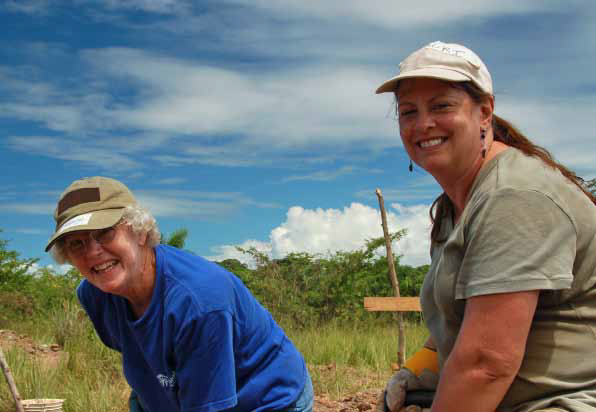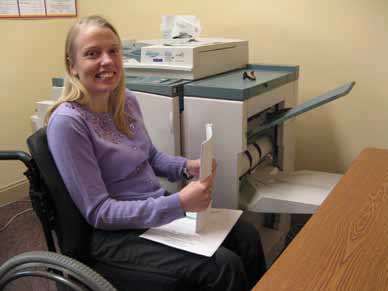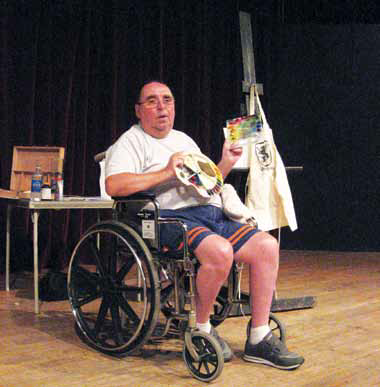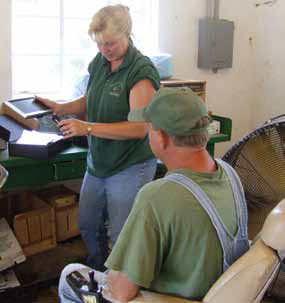Everyone Can Serve
Introduction
Download a PDF of this Publication.

Each state has a governor-appointed state commission on national and community service. These commissions act as a coordinator of service programs in the state, a provider of support to national service programs, and the prime administrator of AmeriCorps*State grants.
Volunteer West Virginia is the state's Commission for National and Community Service and challenges West Virginians to strengthen their communities through service and volunteerism.
The state agency mobilizes resources, promotes an ethic of service, and empowers communities to solve problems and improve the quality of life for individuals and families throughout the state.
Volunteer West Virginia envisions a state where everyone feels a responsibility and has an opportunity for community service and volunteer work; where state government, educational institutions, churches, nonprofits, and service organizations can work together to create and sustain systems that enable people to strengthen themselves and their communities through meaningful focused and well-designed service programs.
For more information about Volunteer West Virginia, visit www.volunteerwv.org.
For more information about the Corporation for National and Community Service, visit www.nationalservice.org.
This handbook was compiled by the Center for Excellence in Disabilities.
All printed materials are made available in braille, electronic format, cassette tape and large-type print. WVU is an Affirmative Action/Equal Opportunity Institution.
National Service and Inclusion
Many state commissions on national and community service have disability coordinators who are responsible for ensuring that individuals with disabilities have the opportunity to actively participate in national service programs as well as other volunteer opportunities.
West Virginia coordinators help with the procurement and disbursement of Disability Placement Funds. These funds are used for the placement of, and reasonable accommodations and auxiliary services for, active and potential service members with disabilities serving in any AmeriCorps*State and AmeriCorps*National Direct program. They also serve as the point of contact to ensure that individuals with disabilities have access to the accommodations and supports that they need during their term of service. These coordinators also provide a variety of other resources that enhance inclusion efforts for both national service and disability organizations.
Some state coordinators also participate in developing a state's disability plan, which summarizes the efforts made by a state commission to include individuals with disabilities.
National Service Inclusion Project
The National Service Inclusion Project is a cooperative agreement between the Corporation for National and Community Service and the Institute for Community Inclusion at the University of Massachusetts in Boston in collaboration with the Association of University Centers on Disabilities.
The Corporation for National and Community Service connects Americans of all ages, backgrounds, and abilities with opportunities to give back to their communities and their nation through service and volunteerism.
Through the National Service Inclusion Project, organizations can:
- Plan a disability inclusion training for program staff
- Increase public awareness of the opportunities national service programs provide for persons with disabilities
- Identify model service programs that are experienced in inclusion
- Obtain contact information on disability organizations in West Virginia
- Plan a targeted recruitment event
For more information, visit https://www.inclusionproject.org/.
Disability Etiquette
People may have two common misconceptions regarding people with disabilities. One is that persons who have severe disabilities may face extremely difficult hardships in their lives. Another is that a person who has a disability would naturally choose not to have a disability if it were possible. It is important to get to know individuals who have disabilities and to overcome these misconceptions. It may become clear to you that the disabilities of others are not seen as barriers, but simply a way of life.
Person First Language

In speaking or writing, remember that children or adults with disabilities are like everyone else- except they happen to have a disability. Here are a few tips for improving your language usage related to disabilities.
- Speak of the person first, then the disability
- Emphasize abilities, not limitations
- Do not label people as part of a disability group- don't say "the disabled." Say "people with disabilities".
- A "disability" is a functional limitation that interferes with a person's ability to walk, hear, talk or learn. A "handicap" is a situation or barrier imposed by society, the environment or oneself.
- Accept persons with disabilities as individuals, entitled to the same respect and treatment you would want for yourself.
- Treat adults with disabilities as adults. You may unintentionally patronize them by telling them how courageous they are, patting them on the back or talking to them like children.
- Speak directly to the person with a disability rather than through a companion or aid.
- Arrange accommodations and be considerate for those who may want to participate in events.
- Do not worry about using common phrases, such as "I'll see you later" or "running errands" or "did you hear about?". Chances are everyone uses these phrases.
- While it is rude to stare or ask personal questions, do not pretend the disability does not exist.
- Be considerate of the extra time a person with a disability may need. Let the person set the pace in talking or walking.
- If you do not understand a person with speech impairments, do not pretend you understand what is being said. Repeat what you do understand or ask the person to repeat the information and allow him or her to reply.
- Offer assistance, but wait until your offer is accepted before you help. If your offer to help is declined, do not insist. Listen to any instruction the person may want to give you.
| Say... | Instead of... |
|---|---|
| Child wih a disability | Disabled or handicapped child |
| Person with Cerebral palsey | Palsied or spastic |
| Person who has | Afflicted, suffers from, victim |
| without speech, nonverbal | Mute, dumb |
| Developmental delay | Slow |
| Emotional disorder | Crazy or insane |
| Person who is deaf or hard of hearing | Deaf and dumb |
| Uses a wheelchair | Confined to a wheelchair |
| Person with retardation | Retarded |
| Has a learning disability | Is learning disabled |
| Has a physical disability | Crippled |
| Seizures | Fits |
| Cleft lip | Hare lip |
| Mobility impaired | Lame |
| Medically involved, or has a chronic illness | Sickly |
| Paralyzed | Invalid or paralytic |
| Has quadriplegia | Quadriplegic |
| Has paraplegia | Paraplegic |
| Born with | Birth Defect |
Benefits to Finding Volunteers with Disabilities
Benefits
It is important to understand that a person who has a disability is just as able and willing to volunteer as anyone else. The community and the volunteers equally benefit from the provided service. Those who have disabilities will be able to volunteer their time to the community while engaging in social interactions and exercise, and the community will benefit from the increased number of volunteers and a more united neighborhood. Accommodating events will also make activities more accessible to not just the volunteers, but to other members of a neighborhood as well.
Finding and Keeping Good Volunteers
Step 1: Awareness
Know what to expect when recruiting volunteers with disabilities and overcome common misconceptions. Many people do not know what to expect from those who require accommodations and are afraid of saying or doing the wrong thing. Many people are not aware that individuals with disabilities may be able to complete tasks naturally or with alternative methods just as well as anyone else. Accommodating the needs of others is not hard or as expensive as you may think.
Step 2: Assessing Needs
- Assess the skills needed that will meet the requirements of the job
- Assess the demands of the task beforehand so you will save time and know how many people you are looking for and their range of talents
- Identify talents of individuals
- Assess needs of individuals
Step 3: Recruiting
- Advertise that you are looking for a variety of volunteers, including those who may have disabilities
- Advertise in the newspaper, radio station or through your local news station
- Seek people from various networks: schools, churches and other volunteer organizations
- Know who you can contact for volunteers and information
- Contact community organizations and state agencies that serve those with disabilities
- See Appendix A for specific contact information
Reasonable Accommodations and Assistive Technology
Reasonable accommodation refers to the adjustment of the environment to suit the needs of a volunteer who has a disability. The best source of information for accommodations will be from the volunteers with the disabilities. Although it is the responsibility of the volunteer to request accommodations, communication from both parties is a key element to providing an accessible environment.
The first step to providing reasonable accommodations is to know the major categories of disabilities.
- Visual:blindness, low vision, color-blindness
- Hearing:deafness
- Motor:inability to use a mouse, slow response time
- learning disabilities, distractibility, inability to remember or focus on large amounts of information.
The following accommodation examples will better prepare you for what you may encounter.
General
- Flexible work schedules
- Increased time to complete tasks
- Environmental accommodations
- Aids and services
Visual Impairments
 Verbal instructions
Verbal instructions
- Microphones
- Audio Recorders
- Information in large print
- A 16-18 pt font is recommended
- Braille
- Magnifiers
- Adaptive devices (microphone, audio recorder)
Hearing Impairments
- Written instructions
- Paper and pencil
- Schedules and timelines
- Computer technology
- E-mail and text messaging
- Audio headsets for advanced hearing
- Assistive listening devices (interpreters and captioning devices)
Mobility Impairments
- Accessible workstation(desk, computer, printer) and alternative access to materials
- Voice activated technology
- Large switches or buttons
- Writing aids
- Accessible walkway and/or entrances
- Flexible work shifts
Cognitive Impairments
- Written information options
- Larger print
- Double space
- Color overlays
- Reading pens, voice output software, recorders
- Organizers and schedulers
Examples of job descriptions for volunteers with disabilities
Receptionist
Job Description - Welcome guests, answer the telephone, fax and copy, go through mail, file papers and record keeping.
Requirements - Requires people skills, organization, and computer experience. Must be available at least 10 hours per week.
Examples of resources and accommodations for volunteers - Volunteers may need plenty of workspace, accessible printer, fax and computer (may need accommodating keyboards or voice recognition software), audio recorders, organizers and schedulers.
Tutor
Job Description - A person who enjoys working with children is needed to instruct students on how to do their homework while teaching fine study habits.
Requirements - Knowledge of the subject material is important. Should have great transportation and are able to schedule tutoring sessions via email or telephone. Must be able to work 3-5 hours each week.
Examples of resources and accommodations for volunteers - May use organizers and schedulers (may have visual or audio features). Email may consist of audio files attached for communication or may be composed using voice recognition software. For those with mobility impairments, transportation is accessible through paratransit vans or busses, taxis, or through other means.
Hospital Volunteers: Cheermobile
Job Description - A volunteer is needed to attend to the "goodie" cart and offer reading materials and gifts to patients.
Requirements - Must be able to deliver items to patients and must be friendly and outgoing.
Examples of resources and accommodations for volunteers - If deliveries are on a time schedule, present a flexible schedule for the volunteer. The volunteer may use an audio recording device to record reminders. Be sure the building and deliver routes are accessible to those in wheelchairs.
Assistive Technology
Assistive Technology (AT)
Assistive technology is any device used to perform tasks that would otherwise be difficult or impossible for people to complete. These devices can be as complex as computers with screen reading software or as simple as Velcro used in place of buttons or shoe laces.
Examples of assistive technology are:
- People who are blind or have low vision can use assistive technology ranging from a magnifier to a screen reader for a computer
- People with physical disabilities can use assistive technology ranging from a cane to a power operated wheelchair
Assistive Technology Act
The Assistive Technology Act provides funds to states to support an assistive technology state plan to increase access to and the acquisition of assistive technology. This applies to individuals with disabilities in education, employment, community living and applies to information technology and telecommunications.
WVATS Assistive Technology Loans
WVATS operates a short-term loan program that can be useful to individuals who need assistive technology for an employment accommodation. Individuals with disabilities and employers can borrow the devices for 30 days to try them out before buying them. The loan library has several devices that can be used to maintain or gain employment including augmentative communication devices, computer peripherals and cognitive aids.
For more information, call West Virginia Assistive Technology System (WVATS) at 1-800-841-8436 or visit http://wvats.cedwvu.org.
Protection and Advocacy for Assistive Technology (PAAT)
Protection and Advocacy for Assistive Technology (PAAT) is designed to increase access to assistive technology for individuals with disabilities. To be eligible, a person must have a disability and be in need of an assistive technology device or service. PAAT can help a person obtain funding to purchase a device or for the purpose of modifying a device to create an individual's independence. The scope of PAAT's advocacy may include providing information, negotiating policy changes, or formally challenging denials and barriers. For more information, call 800-950-9250 or visit https://www.drofwv.org/paat.
Physical Access
Physical disabilities may limit the number of physical tasks an individual can accomplish. People with these disabilities may have limited or no use of their fingers, arms or legs and may have problems with grasping objects, fine motor control and mobility. Creating a checklist of accommodations to provide to an individual will help you to create an accessible environment.
The following are some considerations that will make a friendlier environment for all staff and visitors in general.
- Parking accommodations
- Curb and entrance ramps (36 inches wide)
- Clearly indicated accessible paths with signs
- Slip resistant railings and steps
- Obstructive objects (anything more than four inches from the wall) cleared away.
- Work space, materials, and bathrooms that are accessible
- Handles should be no higher than 48 inches from the floor
- Accommodations for use of a trained service animal
- Communication accommodations
- Office equipment (such as a photocopier and telephone) with braille instructions or large buttons
- Computers with accommodating keyboards and mice
Material Development

"How can I develop materials that are highly accessible?"
Constructing materials to be accessible to a large number of people will be beneficial not only to people, but to you as well. The more accessible the materials are, the more people you will reach. The following are some general guidelines you may want to consider when constructing printed materials, videos and media presentations.
Printed Materials
- Clear, bold lines
- Double spaced
- 14pt-18pt font
- One inch, left-justified margins
- Ragged right margins - not justified
- 50-60 characters per line
- short paragraphs - six or seven sentences
- Easy to read, unformatted fonts
- Designs are not overlaid on top of other designs
- Exaggerated contrasts between background and foreground
- Exaggerated colors (use a lot of contrast: lighter colors lighter, darker colors darker)
- Use paper that has the least glare and the best contrast (non-gloss, light yellow)
Web sites
- Create layouts that are simple and easy to navigate
- Contrast images and characters strongly
- Avoid backgrounds that conflict with the readability of the text
- Use regular fonts (fonts are adjustable to an individual through the browser)
- Create a text-only option for screen readers
- Provide alternative sources for the information (phone numbers and e-mail addresses)
Videos
- Under 10 minutes in length
- Three to four main points
- Use visual, aural, and written information
- Closed-captioning
- Open-captioning
- Closed-signing
- Provide audio recordings as alternatives for those with low vision
Media Presentations
- One idea per slide
- Use 20pt-24pt font
- Use no more than 15 words per slide
- Use Information clear and to the point
- Use key words and avoid unnecessary words
- Use highly saturated (bold) colors but limit using too many different ones
- Use simple and uncomplicated graphics
- Allow plenty of time to transition between slides
- Provide alternative forms of the presentation (outlines and audio recordings)
Assistive Technology
Assistive Technology (AT)
Assistive technology is any device used to perform tasks that would otherwise be difficult or impossible for people to complete. These devices can be as complex as computers with screen reading software or as simple as Velcro used in place of buttons or shoe laces.
Examples of assistive technology are:
- People who are blind or have low vision can use assistive technology ranging from a magnifier to a screen reader for a computer
- People with physical disabilities can use assistive technology ranging from a cane to a power operated wheelchair
Assistive Technology Act
The Assistive Technology Act provides funds to states to support an assistive technology state plan to increase access to and the acquisition of assistive technology. This applies to individuals with disabilities in education, employment, community living and applies to information technology and telecommunications.
WVATS Assistive Technology Loans
WVATS operates a short-term loan program that can be useful to individuals who need assistive technology for an employment accommodation. Individuals with disabilities and employers can borrow the devices for 30 days to try them out before buying them. The loan library has several devices that can be used to maintain or gain employment including augmentative communication devices, computer peripherals and cognitive aids.
For more information, call West Virginia Assistive Technology System (WVATS) at 1-800-841-8436 or visit http://wvats.cedwvu.org/.
Communication Access
Communication is a fundamental, highly evolved part of human nature. When a person is not able to communicate effectively, instructions may get misinterpreted and the ability to share information gets delayed. This is why assistive technology for communication impairments are essential tools in any environment. It is also important for everyone to recognize these tools so that the means of communication is understood and facilitated. The following are various communication methods or tools that you may come into contact with.
- Large print: Printed materials that are between 16pt-18pt font. People who have low vision may also use devices such as magnifiers or reading pens to read material.
- Braille: braille consists of elevated dots arranged to represent characters (numeric and alphabetic) and is a reading aid to those who are blind. Only 10% of those who are blind read braille.
- Accessible information technology (IT): Information technology created by manufacturers to accommodate the functional limitations an individual may have.
- Voice recognition soft-ware: Software that allows an individual to activate or operate devices through voice commands. This assists people with vision or mobility issues.
- Audio: Audio materials are transmitted in a variety of formats and through various digital means. Audio is easily created and is easily accessible. However, it may be difficult to communicate complicated information or use it if the recording is lengthy.
- Interpreters: Interpreters are people who facilitate alternate forms of communication. They are available to people who do not possess English as a first language or to those who have hearing a variety of hearing impairments. American Sign Language (ASL) is one form of signing communication.
- TTY: A teletypewriter (TTY) is a method used by those with speech and hearing impairments to communicate over the phone by texting. Both digital and analogue modes exist. Although teletypewriters are still used, video relay services are becoming more popular.
- Video relay services (VRS): Allows those who communicate through signing to communicate through the telephone with video equipment. The communications assistant is an interpreter who will facilitate the call.
- Captioning: Captioning may be available as "closed-captioning," "closed-signing" or "open-captioning".
Appendix A: Resources
ADA and IT Technical Assistance Centers
The Disability and Business Technical Assistance Center (DBTAC)
Phone: 800-949-4232
Website: www.adata.org
The Arc of Harrison County (Harrison, Randolph)
Phone: 304-624-3641
E-mail: Pat_archc@yahoo.com
The Arc of Marion County
Phone: 304-366-3213
E-mail: thearc@wvdsl.net
The Arc of Mid Ohio Valley (Wood, Pleasants, Ritchie, Wirt, Calhoun, Jackson)
Phone: 304-422-3151
Website: www.arcwd.org
The Arc of Three Rivers (Kanawha, Clay, Boone, Putnam)
Phone: 304-344-3403
Website: https://www.arcthreerivers.org/
Center for Excellence in Disabilities (CED)
Phone: 877-724-8244
Website: www.cedwvu.org
Centers for Independent Living (CIL)
Appalachian CIL (Boone, Calhoun, Clay, Jackson, Kanawha, Putnam, Roane)
Phone: 304-965-0376
E-mail: acil@westco.net
Mountain State CIL (Cabell, Raleigh, Wayne)
Phone: 866-687-8245
Website: http://nwvcil.org/state-centers-for-independent-living/
Northern West Virginia CIL (Barbour, Berkeley, Braxton, Gilmer, Doddridge, Hampshire, Harrison, Jefferson, Lewis, Marion, Monongalia, Morgan, Preston, Randolph, Taylor, Tucker, Upshur)
Phone: 800-834-6408
Website: www.nwvcil.org
Corporation for National and Community Service
Website: https://americorps.gov/
Creating an Inclusive Environment
National Service Inclusion Project (NSIP)
Website: https://www.inclusionproject.org/
Developmental Disabilities Council
Phone: 304-558-0416
Website: https://ddc.wv.gov/Pages/default.aspx
Engaging Persons with Disabilities in Service
Points of Light Foundation & Volunteer Center National Network
Website: https://www.pointsoflight.org/get-involved/
Job Accommodation Network (JAN)
Phone: 800-526-7234
Website: https://askjan.org/index.cfm
Habitat for Humanity of WV
Phone: 304-720-7636
E-mail: state@habitatwv.org
National Service Inclusion Project
Website: www.serviceandinclusion.org
Opportunities, Internetworking and Technology
DO-IT Disabilities
Phone: 888-972-DOIT (3648) (toll free voice/TTY)
Website: www.washington.edu/doit
Rehabilitation Engineering and Assistive Technology Society of North America (RESNA)
Phone: 703-524-6686
Website: www.resna.org
Volunteer West Virginia
Phone: 304-558-0111
Toll Free: 800-WVHELPS
Website: https://volunteer.wv.gov/Pages/default.aspx
World Institute on Disability
Publications and Public Policies regarding people with disabilities
Website: https://wid.org/
West Virginia Division of Rehabilitation Services
Address: P.O. Box 1004
Institute, WV 25112
Phone: (Local) 800-624-3021
(Toll Free) 800-642-3021
(TDD/TTY) 304-766-4970
Appendix B: Laws and Regulations
Americans with Disabilities Act (ADA)
Prohibits discrimination against people with disabilities in employment, public services, public accommodations and telecommunications.
Website: https://www.ada.gov/
Individuals with Disabilities Education Act (IDEA)
Addresses eligibility, individualized education plans (IEP) and teams, evaluations and parental rights for educating children with disabilities.
website: www.wrightslaw.com
WorkForce Investment Act (WIA) and Disability Vocational Rehabilitation Act
Direct services and vocational services are available for people to gain employment and to obtain job training and job accommodations.
Section 504: Requires reasonable accommodation, which includes physical accessibility and effective communication.
Website: https://www.ada.gov/
Section 508: Requires all Federal electronic and information technology be accessible.
Website: https://www.ada.gov/
Telecommunications Act Section 255
Requires all telecommunications equipment to be accessible and usable by people with disabilities.
Website: https://www.ada.gov/
Appendix C: Sources
2. Disability Etiquette
Accessible Attitudes: Disability Etiquette for One-Stop Staff
Employ-ABILITY Handbook
Website: https://adata.org/guide/ada-national-network-disability-law-handbook
Disability Etiquette
United Spinal Association
website: www.unitedspinal.org/pdf/DisabilityEtiquette.pdf
Disability Etiquette Tips for Speaking Engagements
Job Accommodation Network
Website: https://askjan.org/articles/Disability-Etiquette-Tips-for-Speaking-Engagements.cfm?csSearch=4264188_1
Disability Etiquette: Using Words with Dignity
Community Resources for Independence (CRI)
Website: http://www.crinet.org/education/independent%20living/etiquette
Disability Etiquette
Section 504 Handbook contains many etiquette tips related to
- (a) blindness and visual impairments and
- (b) speech disabilities
Ten Commandments of Communicating With People with Disabilities
Ten guidelines for communication and a 26-minute training video or DVD that can be purchased for disability awareness training
Website: www.trainerstoolchest.com/show_product.php?idnum=369
